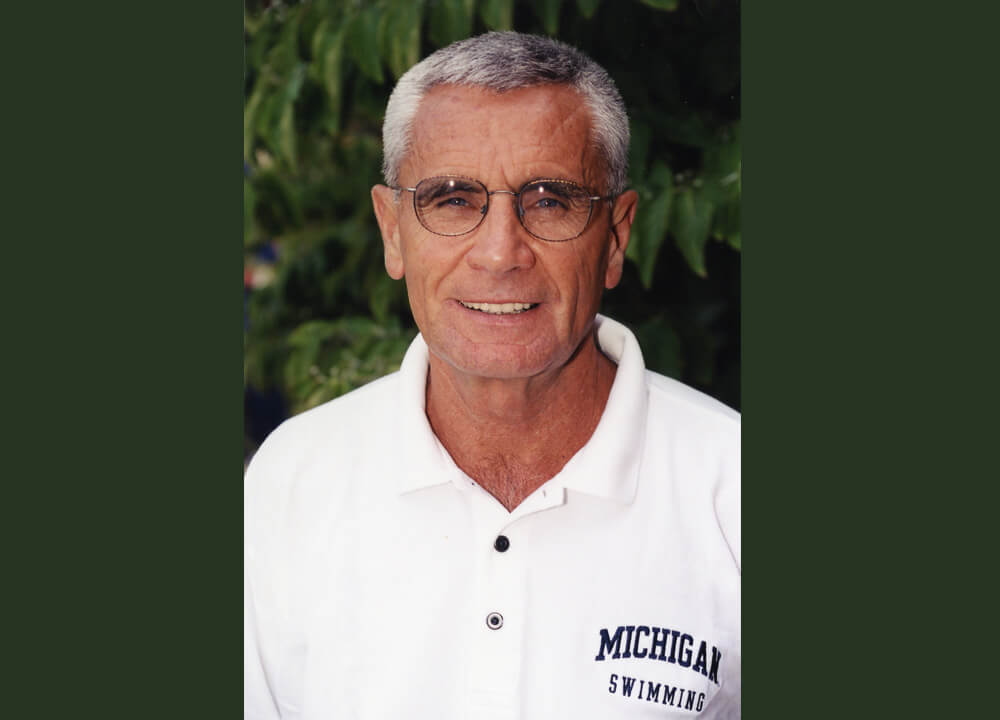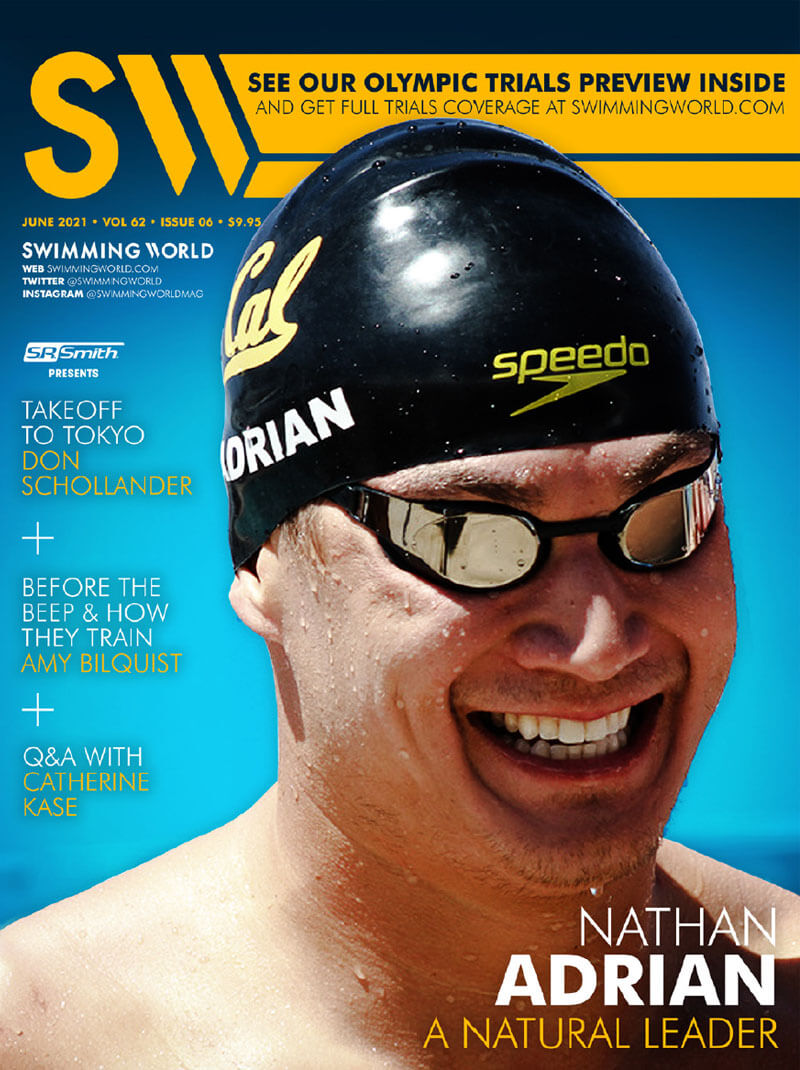Swimming World Presents – A Coach’s Guide To Energy Systems

The latest issue of Swimming World Magazine
is now available for download in the Swimming World Vault!
Non-Subscribers Can Download This Issue Here
A Coach’s Guide Energy Systems
By Michael J. Stott
In the first of two parts, Swimming World explores the concept of energy systems and how coaches can use them to maximize athlete development and performance.
In the world of athletic training—nay any field of endeavor—there are varying degrees of sophistication and understanding.
In aquatics, that may range from beginning summer league coaches to the likes of Ph.D./Olympic mentors, sport scientists and beyond.
A successful swim coach doesn’t have to have an advanced degree in kinesiology. However, a basic understanding of energy systems and how they affect athletic training can certainly help.
THE SCIENCE
Let’s begin with metabolism, the process of storing and releasing the energy. There are three main metabolic pathways to recycle energy in muscle cells during exercise, notes Genadijus Sokolovas, High Performance Director at USA Pentathlon and senior physiologist at Global Sport Technology.
They are non-aerobic (creatine phosphate), anaerobic (anaerobic glycolysis) and aerobic. Energy for body usage is stored in different forms and pathways, and is used to convert the three forms into accessible energy for the athlete (or anybody) to perform work.
“There are no borders to energy pathways in a body,” says Sokolovas. “At any given time, several pathways may be engaged in energy production. However, dominance of an energy source depends on the duration and intensity of the exercise,” he says. “Typically, workload is broken into several energy zones based on that duration and training intensity. Energy zones allow athletes and coaches to develop a specific pathway of energy recycling to quantify, track and plan the physiological adaptations desired for their specific event.”
At one time, USA Swimming identified seven energy zones. These were categorized as Recovery (Rec), Endurance 1 (EN1), Endurance 2 (EN2), Endurance 3 (EN3), Sprint 1 (SP1), Sprint 2 (SP2) and Sprint 3 (SP3). The organization has since reduced the number to five, a number that correlates with those utilized by European coaches. In practicality, the number may be reduced to three: aerobic, anaerobic threshold and high performance endurance with subsets (anaerobic race pace and high velocity overload) found under the high performance category.
Over the years, various coaches and organizations have altered the categories and subsets to suit their training modes and preferences. Grandfather to the codification of the zone system is Jon Urbanchek who, at the University of Michigan, introduced energy category color-coding for ease of understanding and communication with his athletes. Urbanchek’s original chart consisted of seven categories, which he has since modified to five for ease in training.
ENTERING THE ZONE
So how does one effectively measure the utilization of each energy system to perform well? The simple answer is heart rate and time measurement. While heart rate monitors may be the most accurate means, not everyone has a watch with that measuring capability or desire to strap a monitor across the chest. A more convenient and universally accepted method is to place two fingers on the carotid artery, count the number of heart beats (noting the first beat as zero and moving the thumb away from the artery) for 10 seconds and multiply by six.
For that measurement to have meaning, an athlete needs to determine his/her maximum heart rate for each training zone. Training zones are calculated by using BBM (beats below maximum). For example, a swimmer with a maximum heart rate of 210 beats per minute working in the A1 (low-intensity aerobic zone, 60-50 beats below maximum) would need to be functioning at 150 beats per minute.
Another way to calculate each training zone is to use swim and rest times or personal best times +5 seconds or 10 seconds. That method requires a coach to have precise knowledge of swimmer workout and race histories in order to have them training in the proper energy zones.
Michael J. Stott is an ASCA Level 5 coach whose Collegiate School (Richmond, Va.) teams won nine state high school championships. A member of that school’s Athletic Hall of Fame, he is also a recipient of NISCA’s Outstanding Service Award.
Get Swimming World Magazine and SW Biweekly FREE When You
Become A Member of the International Swimming Hall of Fame
30 Day Membership to ISHOF & Digital Swimming World Subscription for just $10 a month!
Want more? Get a 1 Year ISHOF Family Membership With Swimming World Print & Digital Subscription
Non-Subscribers can click here to download this issue for only $5.94
Swimming World June 2021 Issue
FEATURES
12 | U.S. OLYMPIC TRIALS PREVIEW
by David Rieder
The fastest swimmers in the United States will be putting their hopes and dreams on the line at the U.S. Olympic Team Trials-Swimming, June 13-20, in Omaha, Neb. If realized, they’ll have the opportunity to perform next month on the world’s grandest stage: the Olympic Games in Tokyo.
22 | A NATURAL LEADER
by John Lohn
Still producing elite-level performances, Nathan Adrian, now 32 and pursuing his fourth Olympic Games, has the opportunity to further his already lofty reputation. And whenever his days in the sport come to an end, Adrian will be viewed for his excellence in the sport as an athlete, teammate and ambassador.
25 | NJCAA CHAMPIONSHIPS: QUALITY & QUANTITY
by Andy Ross
That’s the same winning formula that Indian River’s men’s and women’s swimming and diving teams have been using for nearly a half-century at the NJCAA Championships. The Pioneer men now have won 47 straight team titles; the women, 39—and 43 of the past 47.
26 | TAKEOFF TO TOKYO: A FORGOTTEN STAR
by John Lohn
By all measures, Don Schollander is a legend in the sport, a Hall of Fame talent who was unrivaled in his heyday. Yet, his impact has been lost to a combination of unfortunate timing and modern-day fascination.
29 | DOMINANCE AND PARITY ON DISPLAY IN TOKYO
by Dan D’Addona
While the U.S. women have dominated international water polo since 2015—winning their second straight Olympics in 2016 plus three World Championships in 2015-17-19—a different men’s champion has emerged at each of the last three major international competitions—Serbia (2016 Olympics), Croatia (2017 Worlds) and Italy (2019 Worlds).
30 | ISHOF: REMEMBERING THE KALILI BROTHERS—90 YEARS AGO
by Bruce Wigo
As kids who preferred to dive for coins rather than race in a swimming pool, brothers Maiola and Manuella Kalili from Hawaii would eventually become national champions and Olympic silver medalists in 1932.
33 | NUTRITION: HOW MANY CALORIES SHOULD I EAT?
by Dawn Weatherwax
As long course, Olympics and endurance events get underway, a common question is: “How much do I need to eat?” This is a loaded question—one in which the author will try to simplify.
35 | MENTAL PREP: BEFORE THE BEEP WITH AMY BILQUIST
by Shoshanna Rutemiller
COACHING
38 | SWIMMING TECHNIQUE CONCEPTS: MAXIMIZING SWIMMING VELOCITY (Part 2)—STROKE CYCLE PHASES
by Rod Havriluk
Swimmers typically decrease non-propulsive time to decrease stroke time, increase stroke rate and swim faster. Research shows that a further decrease in the non-propulsive time is possible and should produce further performance improvement.
40 | A COACHES’ GUIDE TO ENERGY SYSTEMS
by Michael J. Stott
In the first of two parts, Swimming World explores the concept of energy systems and how coaches can use them to maximize athlete development and performance.
42 | SPECIAL SETS: KATIE LEDECKY—RUN-UP TO RIO 2016
by Michael J. Stott
With this month’s Olympic Swimming Trials now upon us, Swimming World takes a back-to-the-future approach to revisit some training done by superstar Katie Ledecky prior to the 2016 U.S. team qualifying meet.
44 | Q&A WITH COACH CATHERINE KASE
by Michael J. Stott
45 | HOW THEY TRAIN HALEY ANDERSON
by Michael J. Stott
TRAINING
037 | DRYSIDE TRAINING: TRAINING AMY BILQUIST
by J.R. Rosania
JUNIOR SWIMMER
47 | UP & COMERS: KEELAN COTTER
by Shoshanna Rutemiller
COLUMNS
08 | A VOICE FOR THE SPORT
11 | DID YOU KNOW: ABOUT BUSTER CRABBE?
48 | GUTTERTALK
49 | PARTING SHOT
Swimming World is now partnered with the International Swimming Hall of Fame. To find out more, visit us at ishof.org





Urby… the best!!!